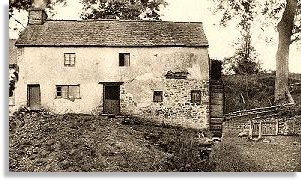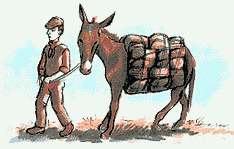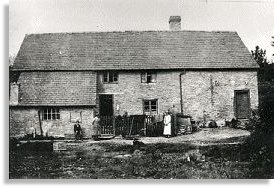
Howey Mill
Radnorshire Museum
Work
Water Corn Mills in Radnorshire

Howey Mill
Radnorshire Museum
The small county of Radnorshire had over seventy working water corn mills in the early part of the 19th century. By 1891 only 39 were operating and the number would decline steadily until there were only a dozen or so by the 1930's.
Most of the corn mills were quite small and ran only two sets of working millstones - one set for grinding flour for human consumption and one set for animal feed stuffs.
I have no one story about any particular mill in 1891 but from various sources I can give some idea of the life of a miller late in the 19th century. Some millers worked on their own and others employed a son or a journeyman miller to assist them. Some with a big enough trade might have had a labourer and/or an odd job boy who later might become an apprentice.

Farmers would take sacks of grain to the mill using their carts. If the quantity was small they would wait for it to be ground and might be offered some beer while they waited. The New Mill at Presteigne had a donkey which could carry 2 1/2 bushels of flour slung on each side for delivery. Gwrd Dwr or Gorther Mill in Beguildy parish also used a donkey led by a boy for small deliveries. The miller at the New Mill would grind, for free, "gooding" corn (pronounced "oo" as in "food") for widows and poor people who had come by it mainly by gleaning out in the fields.

Most of the mills had a house attached to the mill although some of the mills were detached buildings. Because of the damp climate of mid-Wales the grain had to be dried before it was ground. Each mill would have a drying kiln which was usually a separate building. The grain would be spread on the floor of the first storey of the kiln house. The floor would be made from thick perforated terracotta tiles or perforated thick steel sheets. On the ground floor a fire would provide the heat to dry the grain. Kiln houses were popular places for the village lads to gather and talk on cold winter nights when the cosy atmosphere was very welcoming.

Summers seem to have been drier then. Some mills could not work in drought conditions so most of their work was done in the autumn and winter months. Perhaps because of this most mills had a small amount of land - 4 to 10 acres usually - down to pasture and meadow so the miller could keep animals as an additional income. One finds that just before the 1890's the miller at Bleddfa kept the Hundred House Inn as well as running the mill. The same was true at Boughrood where the keeper of the Boat Inn was also the miller, but by 1895 the miller there was also a coal merchant and not an inn keeper.
Thomas Davies the "miller" at Caerfagu Mill, Nantmel in 1881 described himself in the 1891 Census as a "farmer". He lived at the mill with his wife and two children as well as Dennis Cheese, aged 64, described as a "general miller". It would seem that Thomas by then was concentrating on the 10.7 acres that went with the mill which in a sale notice was described as "excellent well-watered pasture land".
It is apparent that millers needed to have additional income available to them. Thomas Rowlands, the miller at Argoed Mill, Nantmel in 1891 had another string to his bow. The mill in the Census that year is described as "Grocer's Shop & Corn Mill". By 1901 Kelly's Directory lists a Mrs. Ann Evans as running the grocery business and a "post office" - so a sub-post office had been added to the mill's diversification. The mill was part of the Doldowlod Estate and the miller was only a tenant.

Monaughty Mill, Bleddfa
The millers sometimes owned their mill but many were tenant millers or worked for estate mills or the mills belonging to large farms. The setting up of large steam driven mills at Liverpool and the other great docks by such companies as Joseph Rank & Co., Henry Leetham & Co and the CWS to produce cheap flour for the rapidly growing urban population in the latter part of the 19th century was driving many rural mills out of business. These large companies were using grain from North America and Australia and contributed to the agricultural depression in Britain at this time and added to the problems of the rural millers.
Contributed by Geoff Ridyard of the Radnorshire Society
Sources:
1841, 1881 and 1891 census returns
Tithe maps and awards, various, c. 1840
W H Howse, MS notebooks
Archival material from Powys County Records Office, various